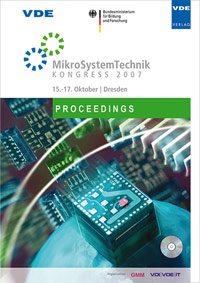Comparison of low temperature bonding approaches for application in micro optical devices
Konferenz: MikroSystemTechnik - KONGRESS 2007
15.10.2007 - 17.10.2007 in Dresden, Germany
Tagungsband: MikroSystemTechnik
Seiten: 4Sprache: EnglischTyp: PDF
Persönliche VDE-Mitglieder erhalten auf diesen Artikel 10% Rabatt
Autoren:
Hiller, Karla; Heinz, Steffen (Chemnitz University, Center for Microtechnologies, Chemnitz, Germany)
Kurth, Steffen; Gessner, Thomas (Fraunhofer IZM, Department Multi Device Integration, Chemnitz, Germany)
Neumann, Norbert (InfraTec GmbH, Dresden, Germany)
Inhalt:
Micro optical devices, such as reflecting mirrors and transparent optical filters, are widely fabricated by Silicon bulk micromachining and wafer bonding. Low temperature bonding technologies are required as the preprocessed wafers can contain metal electrodes, reflecting coatings or electronic components. Furthermore, for these applications it is essential to adjust small gaps in vertical direction very exactly. Two low temperature bonding approaches have been applied, tested and compared with regard to these requirements. The first approach is a low temperature (200 ... 400deg C) bond process based on oxygen plasma activation and subsequent water rinsing. In the second approach, SU-8 is used both for bond surface and for definition of the gap size. Both approaches have been applied to fabricate micro Fabry-Perot-Interferometers and arrays of programmable reflecting micro mirrors, partly with integrated control electronics. The results are compared, especially with regard to the yield of the bond process and the accuracy of the gaps. It is found that for these applications the tolerances are comparable, whereas the bond yield is even higher for the SU-8 bonding approach.


